
views
- Understand the person you're trying to read by asking questions, watching them in groups, and observing their personality's inconsistencies.
- Reflect on their body language, like when they touch you, how close they stand to you, and how their facial expressions change.
- Observe their verbal cues by paying close attention to their tone of voice, the length and mood of their responses, and their word choices.
Establishing A Baseline

Know the person. To really be able to read someone, you have to know them well. By getting to know someone personally, you'll have a better idea of what their likes or dislikes are, what their common habits are, and what is or isn't necessarily a "tell." Base your opinions of others on several encounters with them, not just 1. People may act and speak differently depending on the situation. For example, you may have a friend who is commonly very fidgety. If so, their fidgeting may not be a sign of lying or nervousness. If you were to meet them on the street, common knowledge would deem them nervous or anxious. Nope. They just have an excited leg. Pay attention to the habits of others. Do they maintain eye contact all the time? Do their voices change when they're nervous? When they're preoccupied, how do they transmit it? This will key you in to what you should be looking for when attempting to read them.

Ask open-ended questions. When you're reading someone, you are watching and listening. What you're not doing is grabbing the conversation by the horns and steering it in your direction. So ask your question and get out of there. Sit back, relax, and enjoy the show. Open-ended questions will allow them to talk more so that you can observe them longer. You'll be best off asking to-the-point, pertinent questions. If you say, "How's your family?" you may get a rambling, all-over-the-place response that doesn't help you gauge well the information you're looking for. If you say, "What book are you reading currently?" you may be able to gather more personal information.

Look for inconsistencies in their baseline. A normally affectionate person who seems not to be physically present and doesn't seem to want to get near anyone with a 10-foot pole has something going on; the same behavior exhibited by Boo Radley does not necessarily mean the same thing. Once you've gathered how the person acts in day-to-day life, keep an eye out for the stuff that doesn't mesh. If something doesn't seem to add up, you'll have to ask why, at least initially. They could simply be exhausted, had a fight with their significant other, got yelled at by their boss, or just have some small personal issue that's sticking in their craw. Do not assume it's a reflection of your relationship with that person before you have all the details.

Work in clusters. Seeing one cue is not grounds for jumping to a conclusion. After all, someone could be leaning away from you simply because that chair is hard to get comfortable in. If you are heavily relying on the non-verbal, make sure you have three or four signs before you start making assumptions. Try to a take a cue from their words, their tone, their body, and their face. Once you get one from each and they all line up, it may be safe to proceed. But of course, a good way to ascertain if you're correct is just to be direct and ask.
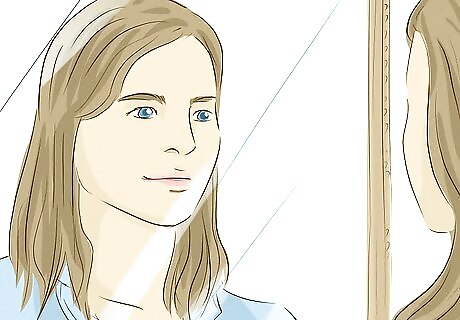
Know your own weaknesses. As a mere mortal human, you are subject to fallibility. Just like the Pope. When you see something pretty, odds are you're going to like it. If it's wearing a finely-tailored Italian suit, you're probably going to trust it. Should you? Not necessarily. Humans generally think of dangerous people as drunkards roaming the street unbathed and carrying a knife. In reality, most psychopaths are charming and have their act together. Though it's virtually impossible to actually take control of, just be aware that your subconscious is telling you to judge a book by its cover when that's not necessarily the best or most accurate thing to do.
Paying Attention To Body Language

Take in how they are holding themselves. Body language can tell you a lot about what someone is feeling, especially when it comes to how comfortable they feel. It may be a reflection of the topic at hand or it could be some interpersonal issue. Here are some general guidelines that indicate comfort level. Positive or comfortable body language cues: Leaning in forward Relaxed limbs that are at their sides Eye contact Smiling that does not look forced or gritted Negative or uncomfortable body language cues: Leaning away from you Crossed arms or legs Limbs that are moving -- a lot of nervous tapping of the fingers or leg, for example Looking away when talking

Look at their face. You should also keep an eye out for fleeting facial expressions. Watch people very closely to see if there are any small movements of the mouth that give away what people are really feeling. For example, a person may smile at you but if their lip twitches, it might mean that they are thinking of something negative. Anything clenched or tense, if even for a second, can be a sign. A furrowed brow, a tense jaw, it's all signs of anxiety. If their eyes close for longer than a normal blink, they're probably stalling and taking a moment to get a grasp on a situation. It generally is an indicator of someone who is losing grip, be it on themselves or in a situation.
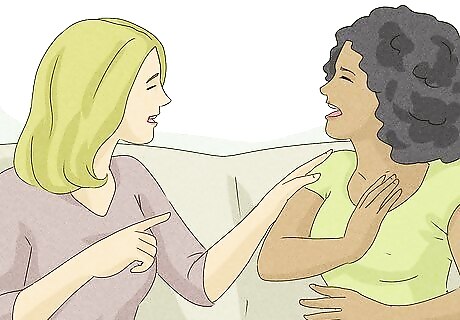
See if they touch you. For example, if a person usually hugs you when they see you but they don't, it might mean that they feel tension towards you. Similarly, think about things like a weak handshake -- that could signify nervousness or uncertainty. Touching is a tough one, though. Everyone has different ideas of a "personal bubble" and just because someone touches you a lot doesn't necessarily mean you're "in." You could just be one in a line around the block. If you're curious about their touching habits toward you, monitor them around other people to see where the norm lies.

Observe how far away they are spatially. How close or far away a person is from you also gives you some insight into their state of mind. For example, if a person is distancing themselves from you physically, it may mean that they do not want to be vulnerable or intimate. Or it could mean they're in a hurry! Again, clusters are key here. Some people are not comfortable being within a certain physical proximity of others regardless of the situation. So just because someone keeps their distance, it may not be a reflection of you. The same goes for the opposite end of the spectrum -- other people have no concept of personal space. If they're violating yours, they may not even realize it.

Consider the cultural relevance of their body language. A person's cultural background will affect the body language they use, their facial expressions, and how close they get to you. It's important to consider these things when trying to read people. You don't want to draw the wrong conclusion about someone because you viewed them through a narrow lens.
Registering Vocal Cues
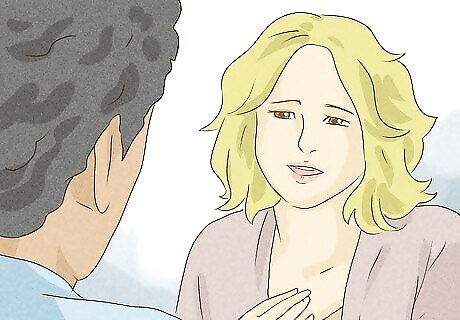
Listen to their tone of voice. A person's voice can tell you a lot about what they're feeling. Listen for inconsistencies in tone or pitch of their voice. Are they simultaneously coming off as happy and angry? They're probably trying to cover something up. Note the volume -- are they talking louder or quieter than usual? Watch to see if they are hedging using their voice, saying "Um," or "Uh," often. If this is the case, they might be nervous or lying and trying to buy time. See if their tone conveys an emotion that they're not expressing outright. For example, do they sound sarcastic or angry? They may feel the need to passively address the situation. If this is the case, it's best to get everything out in the open.

Note the length and tone of their responses. Short, clipped responses to questions could mean that the person is frustrated or busy, while long responses could mean that the person is interested and happy with the conversation.
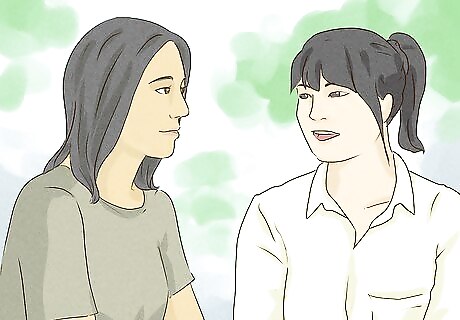
Think about word choice. When people say things, there's always a process underlying the content. If someone were to say to you, "You're dating another dental hygienist?" They're usage of the word "another" indicates that they're actually saying, "You just dated a dental hygienist and that went to crap -- now you're dating another one?!" The recent construction "yeah, no" has become quite popular. Even small two-letter words can be a dead giveaway for ambivalence (or for definiteness or face-saving or assent or dissent or really anything for that matter.) Even if your buddy says, "Dude, c'mon," that can be a small sign. The "dude" there is to indicate solidarity, an acceptable way of saying "friend." So start parsing away those words to get a true indicator of how your target feels.
Reading People In Different Contexts

Know the appropriate tells in a romantic context. On a date, you want to ensure that the other person is also into you. Again, clusters are huge here. It's very common for people (women especially) to be mistaken as interested when they're just being sociable. So stay alert. Watch for body language -- are they leaning forward? Do they have relaxed body language (i.e. no crossed arms or tense shoulders)? These are good signs that the person feels comfortable and interested in you. On a date, try to see how much the other person is talking and how engaged they are in the conversation. If they are interested, they will lean forward, nod when you talk, and ask questions. Look for how much they're smiling. If they seem tense and are not smiling during the entire date, it may mean that they feel uncomfortable. Long eye contact and dilated pupils can also indicate interest from your date. Reader Poll: We asked 638 wikiHow readers, and 71% agreed that dilating pupils during eye contact is the hardest body language signal to pick up on when you’re figuring out whether or not someone is into you. [Take Poll] So if you’re struggling to read that cue, you’re not alone!

Know the constructs of a job interview. Job interviews are nerve wracking and it can often be difficult to gauge how well one went. Keep an eye out for positive body language that means the interview is going well. But also know that in this context, both parties are on high alert for good impressions, so the data points you gather may not be accurate long-term. Again, you will want to make sure that the interviewer is giving out positive body language like leaning in and asking questions. You want them to be revealing that they are interested in you and what you're saying. If your interviewer is shuffling papers or checking his or her computer screen or phone, they may be losing interest. Try to recapture their attention if it seems that they are getting impatient or bored. When you are leaving, see how the interviewer says goodbye to you. Do they give you a firm handshake and genuine smile? These are good signs that mean that the interview went well.
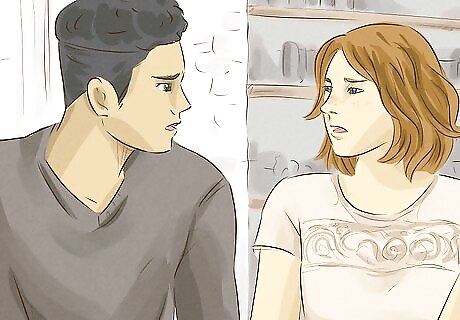
Detect a liar. One of the most common reasons why you would want to learn how to read someone is to see if they are lying. When observing someone to see if they are lying, you want to look for body language and cues that correlate with nervousness. Once more: clusters. Check to see if someone's voice changes, or if they suddenly change their body language. For example, if your spouse usually hugs you and touches you a lot but suddenly stops when you're asking them about something, they may be lying. Do not mistake a person who looks to the side or doesn't make eye contact for a liar because researchers have found no relation between making eye contact and lying. See if they stop using the word "I." Research shows that sometimes when people want to distance themselves from a lie, they will avoid using the word "I" and will instead speak of themselves in the third person (example: "This guy loves a good football game."). See if what they're saying is too elaborate and detailed. Sometimes when people lie, they rehearse a whole story beforehand. If this is the case, watch out for a story that sounds rehearsed or over polished. They fidget and move around a lot. This is a dead giveaway that someone is nervous. If the person you're talking to keeps moving around, tapping their foot, or chewing on a pencil, it may mean that they are lying. Look into their eyes,if their pupils grow bigger while saying something then it is a lie,that's why most poker players wear sunglasses



















Comments
0 comment